
What is the biggest nightmare in the eyes of a gardener? Duh – the dreaded aphid! These buggers may not appear offensive at first, but they really are like miniature vampires that suck the life from your tomatoes until there’s nothing left. If you value your tomato plants and want to keep them healthy, it is essential that these aphid swarms are kept away!
Why be scared of these tiny insects? It’s simple: aphids are like the Kardashians of the bug world – they reproduce faster than a Kardashian can post another selfie. In little to no time, your garden will be overrun by an army of aphids before you even have a chance to grab spray for bugs!
Moreover, have you ever taken a closer look at an aphid? They resemble miniature green aliens with legs – creepy! You don’t want them strolling all over your garden, now do you?
Get ready to embark on a cleansing journey into the weird world of aphid identification and elimination! We’ll delve deep into organic treatments, artificial methods, and all other alternatives. With us as your guide, you’re sure to gain a comprehensive understanding of these pesky pests in no time. So, keep on reading if you wish to get insights on how to get rid of aphids on tomato plants.
Why You Shouldn’t Ignore Aphids on Tomato Plants?
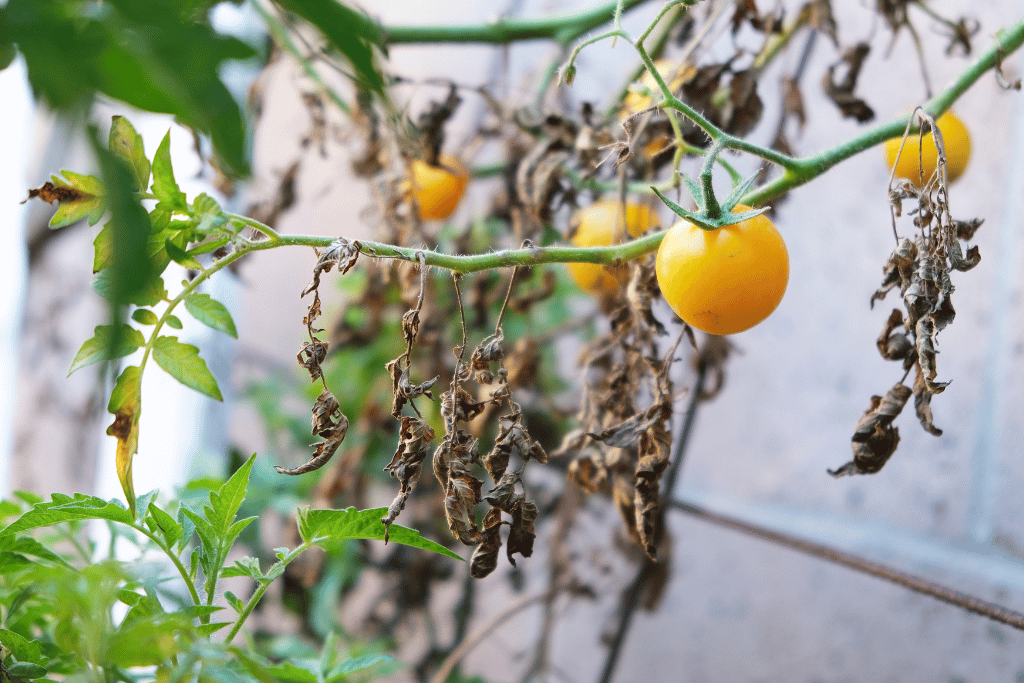
Aphids are a destructive force that can quickly overwhelm your tomato plants, making it harder for you to reap the rewards of your hard work. These small pests feed on the sap of tomatoes and cause wilting, yellowing leaves, as well as stunted growth in extreme cases. If not monitored closely, aphids will thrive unchecked and damage all of your harvests!
Identifying Aphids on Tomato Plants
When monitoring for aphids on your tomato plants, there are several variables to consider. Aphids come in a variety of sizes, shapes and colors – from reds and blacks to whites-plus some even sport wings! It’s like having an enthralling fashion show taking place right before your eyes with these small critters.
In order to tell if your plants are being infested by aphids, look for clusters of tiny green or brown bugs on the undersides of leaves and stems. You may also observe curling or yellowing tomato leaves, which is a sure sign that aphids have been drinking the sap from them. If you come across these indicators then it’s highly likely that you have an aphid problem in your garden.
Red aphids on tomato plants:
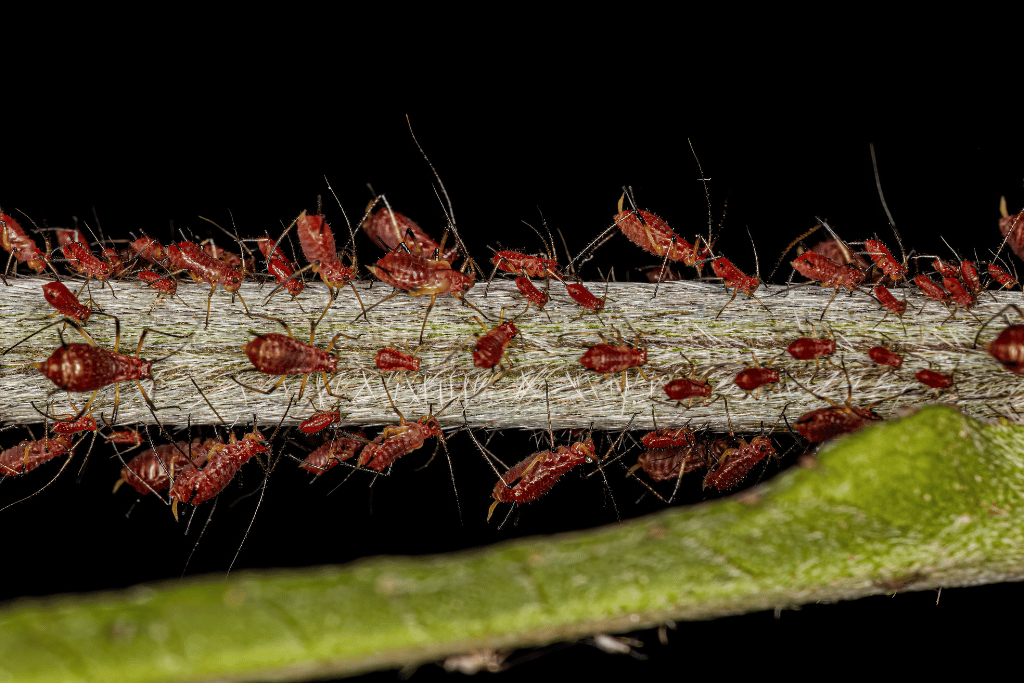
Bright red aphids are an unfortunately frequent sight on tomato plants, as they can be found on the underside of leaves and stems. These sap-feeding pests have the potential to weaken your plant quickly through their speedy reproduction rate; therefore, it’s essential that you take action against them immediately when detected. Red aphids not only damage individual plants but also risk spreading to other nearby flora if left unchecked.
Black aphids on tomato plants:
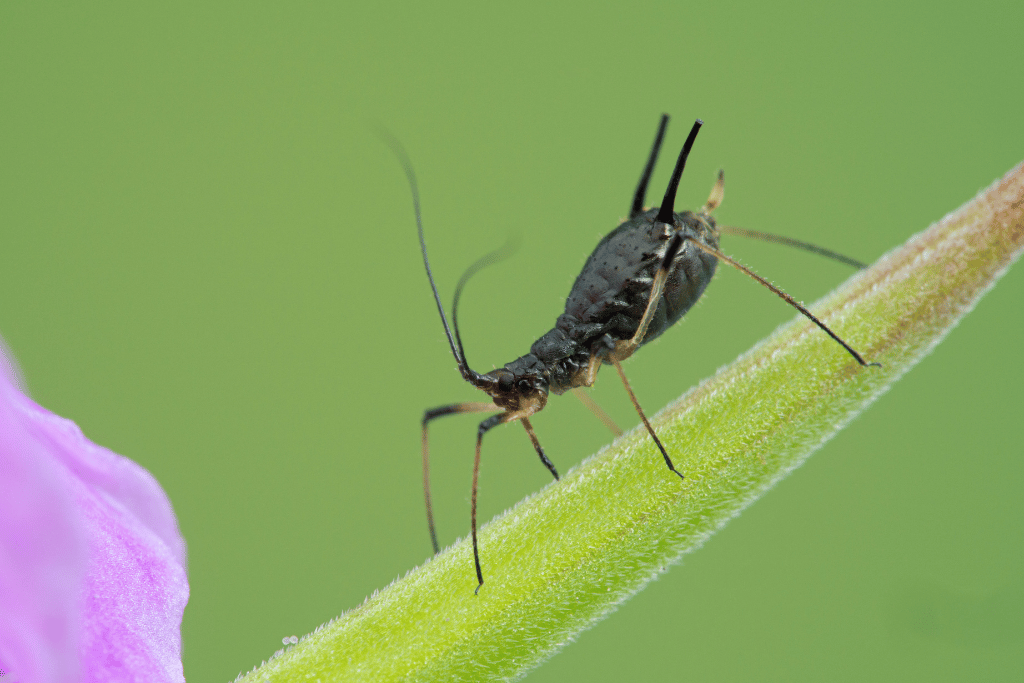
Tomato plants pose danger from black aphids too, which can be either light or dark brown and found both on the stems and undersides of leaves. These pests feed off sap, causing yellowing foliage along with wilting; they may even spread viruses to your tomatoes that make them more susceptible to disease. Keep an eye out for these damaging aphids!
White aphids on tomato plants:
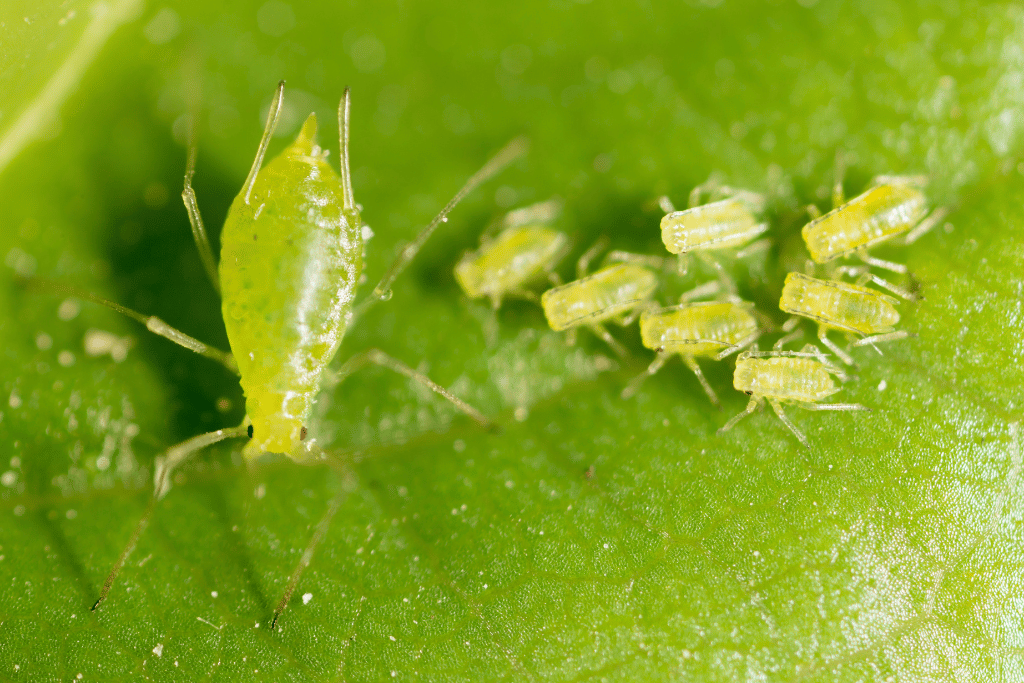
Although less frequent than other aphid species, white aphids can still pose a serious threat to your tomato plants. If left untreated, these small and oval-shaped pests will feed on the plant’s sap which can ultimately damage the leaves and weaken its structure. Since they reproduce rapidly, prompt action is essential as soon as you spot them!
Winged aphids on tomato plants:
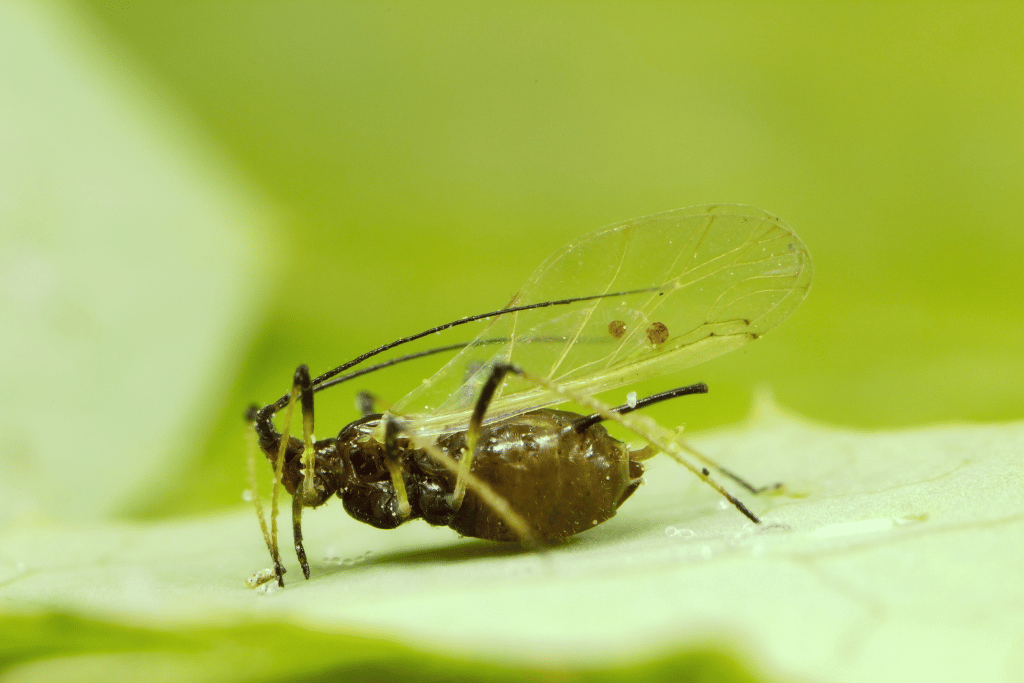
Spotting winged aphids on your tomato plants can be tricky due to their ability to fly. Usually, these pests are green or brown and they live off sap from the leaves and stems of the plant. This sap-sucking behavior causes harm to the foliage while diminishing overall vigor over time; what’s more is that if left untreated, they will rapidly spread across other nearby vegetation too. Therefore it is crucial you take action once you recognize them among your plants!
Identifying And Controlling Aphids on Tomato Plants – Quick Glance!
| Identification | Control |
| Look for small, soft-bodied insects on the undersides of tomato leaves | Hose off aphids with a strong jet of water from a garden hose |
| Look for curled or distorted leaves, yellowing, and stunted growth | Prune affected leaves and stems |
| Look for honeydew, a sticky substance that aphids excrete, on leaves and surrounding areas | Apply insecticidal soap, neem oil, or other organic insecticides |
| Look for ladybugs, lacewings, and other natural predators in your garden | Introduce beneficial insects or plants that attract them, such as marigolds or fennel |
| Look for ant colonies, as they often protect and farm aphids for their honeydew | Use sticky barriers or other methods to prevent ants from climbing onto plants |
| Look for signs of infestation early and act quickly | Monitor plants regularly and apply treatments as needed |
How to Kill Aphids on Tomato Plants

Now, let’s talk about how to kill aphids on tomato plants. To begin with, I’m a huge believer in natural solutions. After all, who wants to douse their precious tomatoes with chemicals if they don’t need to?
So, if you’re looking for ways on how to get rid of aphids on tomato plants naturally, here are a few options to consider:
Home remedy for aphids on tomato plants (Natural methods)
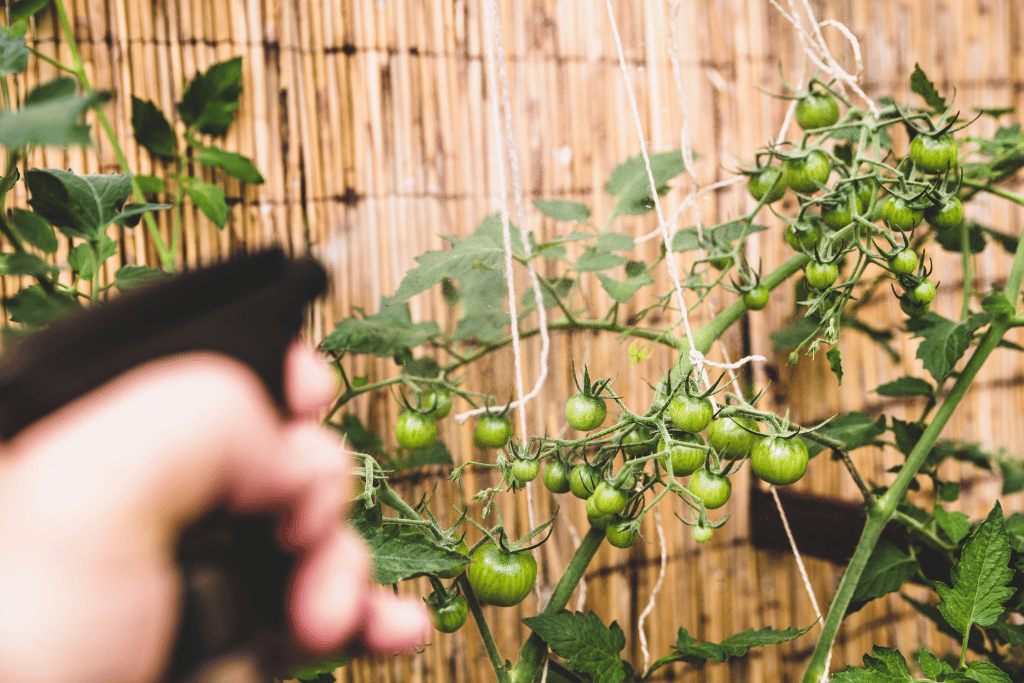
An effective way to naturally combat aphids is by introducing their predators like ladybugs and lacewings; these natural predators will feast on the tiny pests.
Take control of your tomato plants by creating a homemade insecticidal soap. Simply combine water and several drops of dish soap to formulate the spray, then apply directly to affected areas on your tomato plants. The mixture will smother aphids, preventing future infestations!
Transform your tomato plants with neem oil, a natural insecticide extracted from the neem tree! Simply mix it with water and spray on your plants to ward off aphids.
Utilizing the power of companion planting can bolster your garden’s defenses against aphids. Marigolds and garlic, for example, are natural deterrents to these pests; plant them in close proximity to your tomato plants and reap the rewards!
Chemical methods of controlling aphids
If your natural remedies are not working to curb the serious aphid infestation, it’s time to consider chemical solutions. Here are a few potential options:
Insecticides: To efficiently combat aphids, you should look into insecticides available on the market. However, be sure to read each label cautiously and comply with instructions accurately in order to safeguard your tomato plants from any possible damages.
Systemic pesticides: These insecticides penetrate the tissue of plants, eradicating aphids from within.
Synthetic pyrethroids: Chrysanthemum-based insecticides are commonly used to combat aphids, however they can also cause harm to beneficial pollinators such as bees and ladybugs.
Other ways of controlling aphids
Introduce Ladybugs: The natural aphid predators, Ladybugs, are an effective way to keep your garden safe. Whether bought online or at a local gardening center, introducing them into the tomato plants will help reduce pest populations. Additionally, these bugs will consume the insects that have been causing trouble while they roam and reproduce. With Ladybugs you can finally put an end to your struggle with pests!
Beneficial nematodes: For natural and effective pest control in your tomato garden, consider introducing beneficial nematodes. These tiny worms feed on the larvae of many common pests, such as aphids–without harming plants or other organisms! You can find them online or at a nursery to apply around your tomatoes for unbeatable protection against insect infestations.
Companion planting: Companion planting is a great technique that involves strategically placing plants together to create an advantageous environment. Marigolds and chives, for example, are natural bug deterrents so they can be grown right beside tomato crops in order to repel aphids.
Garlic spray: Get rid of certain pesky aphids on tomato plants using the power of garlic! Simply mince a few cloves and steep them in water for several days before straining the mixture. Then, take that garlicky concoction and spray it on your tomatoes – not only will its strong odor drive away any aphids nearby, but those unfortunate enough to come into contact with it will perish as well.
Prevention Methods of Controlling Aphids
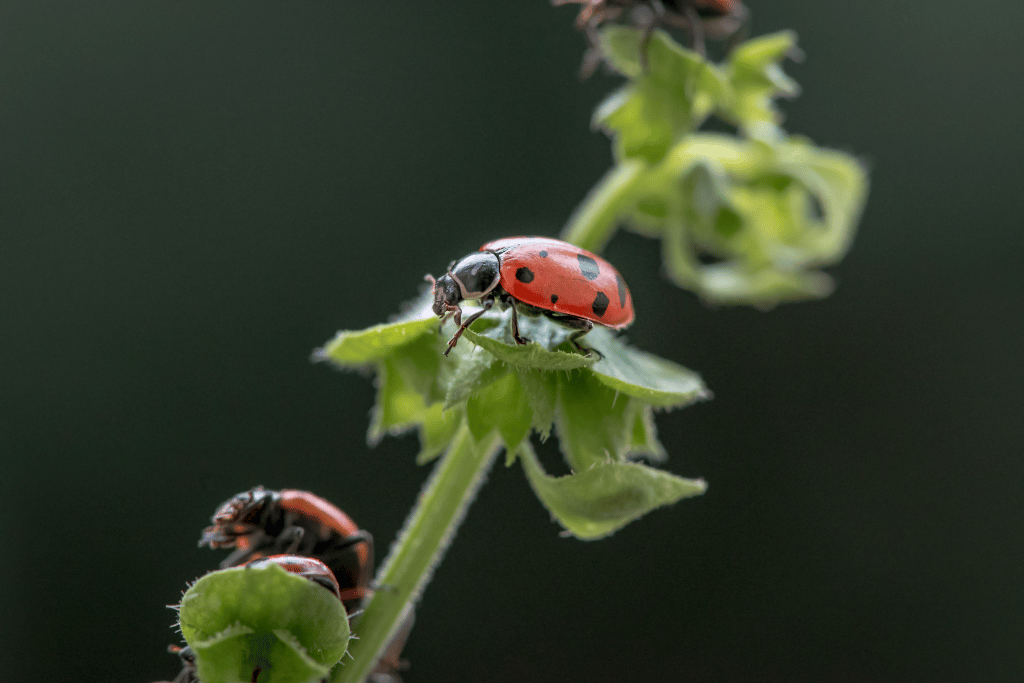
Of course, the best way to control aphids is to prevent them from infesting your tomato plants in the first place. Here are a few tips to keep in mind:
Regularly inspecting tomato plants:
Knowing what’s going on with your tomato plants is essential in order to identify any aphid infestations before they become unmanageable. Vigilant monitoring will help you take the necessary steps promptly, avoiding a potential disaster.
Removing infested plants:
To stop infestations from spreading, it’s imperative to remove any tomato plants with aphids right away.
Providing proper nutrition and care for your tomato plants:
To ensure your tomato plants are able to better fend off aphid infestations, a healthy and nutritious enriched diet is essential. Consistently provide them with the correct measurements of water, sunlight and nutrients for optimal growth.
Keeping the surroundings clean:
A tidy garden is a healthy one, so ensure that you clear away any fallen leaves or debris to avoid attracting potentially harmful aphids.
Introducing beneficial insects:
By introducing predatory insects such as ladybugs, lacewings, and hoverflies into your garden’s ecosystem, you can combat aphids more effectively. These beneficial bugs consume large amounts of aphids to protect plants from being eaten or damaged by them. Utilizing natural predators is an additional layer of defense against the annoying pests!
With the correct precautions and monitoring, you can effectively defend your tomato plants against aphids, ensuring that these pesky bugs stay away. Act now to maintain a healthy garden!



